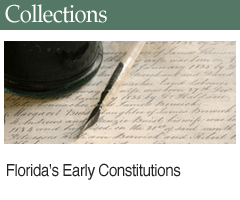1845 Election Returns
Using the Collection
What Can These Documents Tell Us?
Historians and genealogists can both find useful information in these election returns. The documents are historically significant in part because they provide a snapshot of the voting process in Florida in 1845. Researchers can also use the returns to get a very rough sense of population density for each precinct, and in some cases useful information about individuals. Occasionally, a person's right to vote was challenged, and the law required election officials to explain how the challenge was resolved. This may be useful for historians interested in studying a particular individual or patterns of the voting process in general. The documents do have their drawbacks. Unlike census returns, these documents do not record the names of women, children, African-Americans, or those who chose not to vote.
The value of the collection for genealogists is that these election returns place individuals in a very specific location at a very specific time. The election occurred in 1845, halfway between the taking of the 1840 and 1850 federal censuses. Many families moved into Florida during this period, and for some of these families the 1845 election returns may be the earliest record of their having arrived in the state. These election returns do not provide detailed demographic data about individuals, but researchers can use this resource to determine the county and precinct in which they lived in May 1845. When looking for an ancestor who moved around a few times before settling, this can be very helpful for identifying where to look through county records for more information.
Best Practices for Searching
When searching the 1845 election returns, first keep in mind that the State Archives presents this as a historical collection. We have preserved the information as it appears in the original documents. That means any misspellings, misidentifications, or other errors on the part of the original creators of the documents are preserved as well. If you are searching for a specific person or a place you know should exist in this collection but for some reason it is not listed, consider broadening your search. A different spelling of the surname, an abbreviated first name, or a county boundary change between 1845 and today might be the culprit.
When looking for a specific individual, the best way to start is to choose "Browse by Voter Name". This page provides a table listing all 5,747 individuals who appear either as a voter or election official in the documents. Click on the "Voter Name" column heading to sort the list by name, and scroll down to find the name you are looking for. To save time, consider using your browser's Find function by typing either Ctrl + f (Windows) or ⌘ + f (Mac). Click on the precinct name listed in the middle column for any individual to view the election return document for that person's precinct. An index of voters for each precinct is provided.
If you do not find the individual you were looking for, consider searching for similar surnames. The officials managing this election recorded all of the information by hand; mistakes are common. A man named "Parsons" might easily be recorded as "Persons", or even "Pierson" or "Pearson". Also, if you are looking in a specific precinct, consider that an individual may have moved in between census years, so an ancestor who lived in Alachua County in 1850 may not have lived there in 1845. Furthermore, county boundaries have moved numerous times over the years. What is located in one Florida county today may have been part of a different county in 1845.
Common Abbreviations for Given Names
Also note that election officials in 1845 were not as concerned as we are today about standardizing names. They often used abbreviations for given names, even on official documents. George could become Geo., John could become Jno., and so on. Here are a few examples:
| Abbreviation | Name |
|---|---|
| Alex. | Alexander |
| And. | Andrew |
| Benj. | Benjamin |
| Chas. | Charles |
| Danl. | Daniel |
| Edw. | Edward |
| Ezek. | Ezekial |
| Fred. | Frederick |
| Geo. | George |
| Hen. | Henry |
| Jas. | James |
| Jno. | John |
| Abbreviation | Name |
|---|---|
| Jon. | Jonathan |
| Jos. | Joseph |
| Nath. | Nathaniel |
| Pet. | Peter |
| Richd. | Richard |
| Robt. | Robert |
| Saml. | Samuel |
| Sol. | Solomon |
| Theo. | Theodore |
| Thos. | Thomas |
| Vinc. | Vincent |
| Wm. | William |
In addition to finding individuals, you can also use this database to find out who was living in a particular area at a given time. If you are interested to know who lived in the vicinity of a specific person, follow the previously explained steps to find that person's precinct. The index of names should provide you with a good idea of who lived near that person.
If you do not know the names of any specific individuals living in the place that interests you, start by choosing "Browse by County or Precinct" from the navigation bar at left. Follow the directions to select a county, keeping in mind that these documents are based on 1845 county boundaries. A list of precincts is provided under each county name. This will allow you to see the list of people who voted in specific locations around each county. Researchers may use this method to find out which families had settled in various parts of a county by 1845.

 Listen: The Assorted Selections Program
Listen: The Assorted Selections Program


